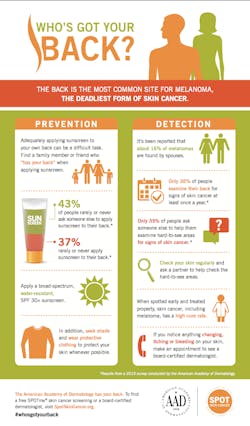Introduction: Summer brings professional meetings and higher UV exposure
While you read this, I will be in London at EuroPerio 8. It is my favorite dental meeting in the world, held every three years. Previously, the meetings were held in Vienna and Stockholm. In addition to periodontists and dentists, they welcome dental hygienists and students. The speakers are always extremely informative, and the social functions allow for networking. And it is in London! I will report on the meeting in future newsletters.
With summer fast approaching, in addition to attending meetings like RDH Under One Roof and the ADHA Center for Lifelong Learning, many of us will head to the beach. (1, 2) We all know that the sun can cause skin cancer, so the American Academy of Dermatology has started a new campaign. Because it is difficult to apply sunscreen to one’s back, they are urging us to ask someone else to help apply sunscreen to their back. As well, asking for help in examining hard-to-see areas of the skin for signs of skin cancer. (3)
In other news, the American Dental Hygienists’ Association (ADHA) and the Oral Cancer Foundation (OCF) helped to raise oral cancer awareness. The “Be Part of the Change” campaign used social media and the ADHA Update to engage dental hygiene professionals on this important topic. ADHA Member Shavonne Healy of Washington, D.C. is the winner of the “Be Part of the Change” contest. (4)
We discuss many health issues and technology in this issue. A new tech, EZ-4-U company delivers healthcare services by means of a smartphone. (5) It allows patients immediate access to physicians and nurse practitioners, totally through a computer or smartphone. The professionals are US-educated and boardcertified. The web-based service provides 24/7 access to doctors and nurse practitioners. They list fees, take credit cards, and have a FAQ section.
A scary thought for sushi lovers: Among women of reproductive age, exposure to mercury at low levels was associated with markers of immune system disorders. (6) Autoimmune disease can include such conditions as inflammatory bowel disease, lupus, scleroderma, Sjögren’s syndrome, rheumatoid arthritis and multiple sclerosis. These are among the 10 leading causes of death among women. Investigators examined diet surveys and mercury levels of over 1,300 women between the ages of 16 and 49. They also tested for antinuclear antibodies (ANA), proteins that attack the body’s own tissues, through blood tests. They may indicators of autoimmune disorders.
Not everyone with high levels of ANA will develop autoimmune disease. The question remains, how can one limit exposure to mercury? The FDA and the EPA state that pregnant women can safely eat up to 12 ounces (340 grams) of seafood a week. (7) Fish such as swordfish, king mackerel and tilefish contain the highest levels of mercury, while shrimp, canned light tuna, and salmon have lower levels. The document on the FDA website is being updated and should be considered a draft. Once finalized, it will replace the current advice which was issued in 2004. (7)
And lastly, the CDC has a page devoted to Hispanic Health. (8) Numerous resources are available. Thanks again to Christine Charles for her contribution to this issue. Happy reading!
Sincerely,
References
1. http://www.rdhunderoneroof.com/index.html.
2. http://www.adha.org/annual-session.
3. http://www.pwrnewmedia.com/2015/aad/spot_skin_cancer/index.html.
4. www.adha.org/resources-docs/ADHA_Oral_Cancer_Press_Release_4-13-15.pdf.
5. http://ez-4-u.com/.
6. Somers E, Ganser MA, Warren JS, et al. Mercury Exposure and Antinuclear Antibodies among Females of Reproductive Age in the United States. Environmental Health Perspectives, Feb.10, 2015.
7. http://www.fda.gov/Food/FoodborneIllnessContaminants/Metals/ucm393070.htm.
8. http://www.cdc.gov/vitalsigns/hispanic-health/index.html.


